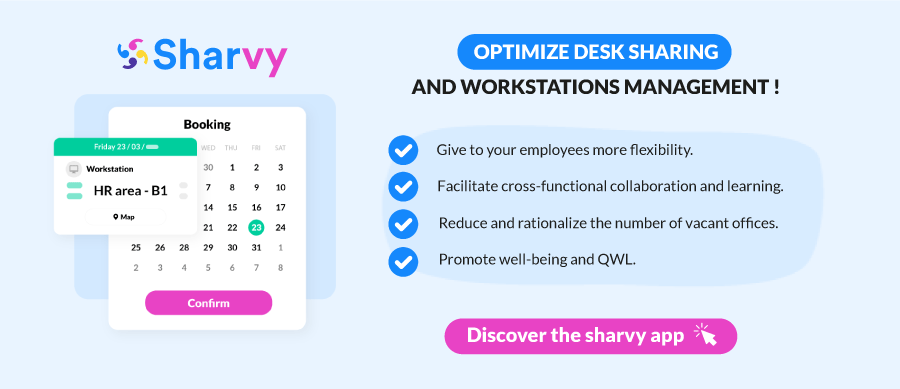In a company, the most successful employees are those who feel happy & fully fulfilled in their work environment. However, to apply this theory, many employers, HR departments, and managers rush into a quality of working life (QWL) approach.
So, many have associated this acronym with benefits that are not work-related — for example, installing a table football in a break room, introducing yoga classes during the break, or organizing aperitifs after the working day. However, companies that present these practices claim to be virtuous in terms of QWL, but in reality, they are only skimming over it.
Do you think that these practices are enough to improve working conditions? The answer is no. They do not fit into this perimeter since they are disconnected from it. Consequently, and still today, many companies need to understand what QWL means entirely.
Therefore, by no longer talking about QWL but about “Quality of Life and Working Conditions,” companies can provide a more explicit speech on how employees carry out their work.
So, if you want to learn more about this subject, find out in this article what “Quality of Life and Working Conditions” encompasses and what actions you can take to improve it in your company!
From the QWL to “Quality of Life and Working Conditions” : why this change in terminology?
Since 31 March 2022, the acronym QWL for “Quality of Life at Work” has been replaced in the French Labour Code by “Quality of Life and Working Conditions.”
This terminology change makes it possible to remove a certain number of tricks that contributed to confusing the first definition of QWL! And finally, to reduce it only to moments of conviviality and relaxation in the company.
This is why it became essential to give weight to the initial definition and to reinforce the importance of working conditions, which had been gradually erased.
How could this be done? Essentially, by giving employees back the possibility of expressing themselves and participating in all possible areas, in terms of :
- Work organization (flexibility, harmonious articulation of professional and personal spheres, the introduction of teleworking, etc.) ;
- Working conditions (management, resources, and interpersonal relations) ;
- Health prevention (anticipation of psycho-social risks (PSR) and burn-out).
These aspects concern managers and HRDs, but they must also consider the perception of the employees’ work. This is done by considering each individual’s profile, conditions, and expectations.
Improving the QWL : how does it work & what should we pay attention to?
The National Association of HRDs (ANDRH) has defined the six pillars of a practical & co-constructed QWL approach. Consequently, it is essential to know that this approach is based on the following :
- A diagnosis & regular measurement of progress
- A participative dynamic by involving employees in the organization of work
- Also, a collective dimension by training all the actors in the company & at all levels
- A professional dialogue to communicate the quality of work & the means of action
- Continuous reflection on the improvement of working conditions
- A logic of experimentation with implementing “Test & Learn.”
Among these, and to develop a stable & resilient environment in the long term, particular attention must be paid to two pillars :
- Communication via the establishment of professional dialogue moments
- Improving organizational performance through the logic of experimentation.
However, to achieve this, implementing a successful QWL approach requires a series of concrete & practical actions in the service of the six pillars. Discover some examples of actions below!
5 concrete & practical actions to improve the QWL in your company!
1. Optimise your office layout for better working conditions
The working environment is becoming increasingly crucial in employees’ lives and considerably influences job satisfaction. This is why it is becoming essential to place the layout of your premises at the heart of your QWL approach!
Here are some ideas to consider :
- Make room for open and spacious areas, such as open spaces
- Encourage interaction between open spaces by creating circulation corridors.
- Install ergonomic desks and chairs
- Favour areas exposed to daylight, which are more pleasant for your employees
- Install relaxation areas that are conducive to informal exchanges
- Vegetalize your workspaces! A study by Cardiff University has shown that the presence of flowers and green plants improves productivity, reduces stress, and boosts creativity.
But that’s not all! To improve the working conditions in your company, remember that this friendly environment should maintain the concentration of your employees. That’s why, and to make sure of it :
- Invest in acoustic booths for meetings, video-conferences or calls.
- Install acoustic walls along strategic axes or around work islands.
- Create corpoworking areas and hot-desking zones to clearly demarcate work spaces.
✔ Our advice :
At the opposite of traditional offices, many companies are opting for the Smart Office. The reason is apparent : it allows reinventing employees’ workspaces by integrating various technologies (intelligent sensors, mobile applications, IoT platforms & solutions, etc.). Today, it is gradually becoming a mediator of well-being at work and helps to improve the QWL.
For example, your employees can reserve a workstation through a dedicated application, such as Sharvy. At the same time, they can find out what is available in the next few days. This allows them to organize their week more easily according to their wishes and/or personal constraints. Also, this is a great way to improve their daily life and working conditions. This can be a great initiative to implement to enhance your QWL!
2. Organise federative and convivial events
Undoubtedly, the organization of events and the realization of team building in companies are standard and essential levers to put in place! By bringing your teams together around an activity, you strengthen the links and cohesion between your employees.
At the same time, and depending on the activity chosen, your employees will better understand each other’s strengths and weaknesses and learn to work together by getting the best out of each other’s behavior. For example, periodically, you can set up the following :
- Lunches and afterworks
- Sporting events to improve the QWL (and the health of your employees!)
- As well as full-scale games: an escape game, a murder party, etc.
- Seminars outside the company to get some perspective and think about tomorrow
- Conferences with inspiring speakers & who engage in dialogue around a topic
- Knowledge-sharing times, in-company, to raise your employees’ awareness on various topics, for example, climate, by organizing a climate mural.
✔ Our advice :
Remember that team building already exists within your company’s walls, in the heart of your daily missions. This is where it is most important! Also, this is why you must remember, as popular as it may be, that this federative and convivial event will only allow you to solve some of the relational problems within your company. So, this is why improving the QWL must be kept from this event.
3. Adopt a benevolent management style
There are no secrets : management is a central issue in quality of life at work. A company that is sincerely committed to CSR implements responsible and transparent governance. It is, therefore, consistent that it adopts a benevolent management style.
However, when we talk about human management, many say we should remember the requirement for fear that benevolence is perceived as a form of laxity. However, is benevolence synonymous with complacency and ‘carefree’ management? Does being demanding mean pressuring people with disciplined management and pushing them to their limits? No! Let’s get away from common thinking and beliefs.
Today, the vital thing in a company is to find the balance between benevolence and demands.
In this way, by adopting a benevolent attitude within your company while at the same time making demands for quality and balanced productivity, and by offering your support and help, your employees will be all the more motivated to achieve their objectives!
Therefore, keep in mind that the application of benevolence in working relationships releases positive energy, promoting well-being at work, QWL, but also :
- Communication & transparency
- Initiative-taking & creativity
- As well as : recognition & consideration.
✔ Our advice :
If you want to improve the working conditions of your employees but also perform sustainably, you need to keep two things in mind. First, demanding without benevolence leads to unnecessary pressure that will deliver only short-term and unsustainable results. It causes tension and unsuccessful stress, leading to delays, absenteeism, and disengagement. In the same way, benevolence without demands is not a stimulant and source of performance for the company. Therefore, it is about finding the right balance between these two notions.
4. Make your workplace more accessible with your company car park!
It may seem secondary, but intelligent management of shared spaces in companies (car parks, offices, cafeterias, etc.) is central to the quality of life at work.
However, company parking is one area that deserves the most attention today. Indeed, the freedom and convenience of parking are no longer the primary concern in large cities. This is why the lack of parking can quickly become an absolute nightmare for users! In addition, it can be a natural source of stress and anxiety which never bodes well for the start of a working day.
Therefore, to facilitate not only the daily life of employees but also to make it easier for potential visitors to come to the site, companies have every interest in offering a car park and giving access to all or some of the employees.
On this subject: is your company car park well optimized? Take our quiz to find out and discover where you can improve.
✔ Our advice :
With the growth of teleworking, employees’ travel and days off, if you have a company car park, this is rarely entire! This is because so many spaces remain vacant when others could use them. To avoid this, and ultimately to double the number of people who have access to the car park, you can consider implementing smart parking. This will solve your employees’ recurring parking problems and improve their arrival on-site and QWL and loyalty to your company.
5. Prevent psychosocial risks (PSR) – an important point to improve the QWL!
Let us remember that psychosocial risks were the origin of the concept of quality of life at work. This is why it is crucial to improve your QWL by implementing a prevention policy.
As a reminder, the term “psychosocial risks” mainly covers :
- Stress at work (work overload, lack of resources, autonomy, etc.).
- Internal violence (conflicts, moral or physical harassment, etc.).
- External violence (threats by a client, physical and/or verbal aggression, etc.).
These risks impact the physical and mental health of your employees and, in correlation, the functioning of your company (absenteeism, staff turnover, working atmosphere, and conditions, etc.).
This is why, to improve the QWL within your company, one last point, and not the least, is to act (in a concrete way) to prevent these risks. In particular, by :
- Identifying the psychosocial risk factors specific to your activity
- Assessing these different risks via a self-assessment: to help you, consult this guide.
- Carrying out an action plan to implement an effective prevention policy!
✔ Our advice :
Remember to distinguish three prevention levels for an effective prevention policy :
- Primary prevention (which aims to eliminate risks at source).
- Secondary prevention (which aims to protect your employees by helping them to cope with exposure to threats).
- Tertiary prevention (which allows an action to be taken to reduce disorders due to hazards that could not be avoided).
In conclusion
At first glance, you might think that one more letter is not going to change the original definition of QWL very much! And yet, the QLWC marks a far more important breakthrough in terms of health at work than might first appear. Finally, the evolution of this acronym reminds companies that their performance cannot be built without taking daily action on the quality of life and working conditions of their employees!
This includes attention to the prevention of occupational risks, managing workload, and promoting a healthy social climate. This integrated approach helps create an environment where employees feel valued and supported, which, in the long run, fosters sustainable productivity, reduces psychosocial risks, and strengthens team engagement.
So it’s a new, broader definition that makes employees and the way they do their work the focal point of the organization.
Have a question ? Check out the FAQ !
Why start a QWL initiative in your company?
Implementing such an approach represents a strategic challenge to reconcile work performance, health, and well-being. There are many benefits. It is a way of developing your employer brand to attract and retain your best talent. It is also excellent for giving meaning to work, boosting motivation, and improving your employees’ commitment. In correlation, their productivity will increase to benefit your company’s overall performance. Finally, this approach also helps to prevent psychosocial risks, reduce absenteeism and promote health at work.
How to measure the QWL in your company?
QWL can be measured in different ways. For example, by monitoring indicators on the health of your employees (rate of occupational illness, unfitness, accidents, etc.). In parallel, you can measure QWL through perception indicators (satisfaction, sense of fairness and belonging, role clarity, commitment, etc.). In addition, you can also monitor operational indicators (absenteeism, turnover, training, etc.).
How can QWL be reconciled with the imperatives of economic performance?
Firstly, promoting a working environment conducive to QWL can make a positive contribution to economic performance. Satisfied and committed employees tend to be more productive and creative and are more inclined to contribute to the achievement of organizational objectives. As a result, investment in QWL can be seen as a proactive strategy to increase operational efficiency.
Secondly, implementing management practices that focus on employee well-being can help retain talent and reduce the costs associated with staff turnover. Reduced turnover leads to organizational stability, reducing training costs and preserving human resources within the company.
Thirdly, integrating innovative solutions such as teleworking, flexible working hours, and other work-life balance practices can improve QWL without compromising productivity. These practices can also help attract skilled and diverse talent.
Ultimately, reconciling QWL with the imperatives of economic performance requires an integrated approach, in which investments in employee well-being are seen as strategic levers for strengthening a company’s competitiveness and long-term sustainability.
How can we ensure the sustainability of QWL initiatives over time?
The sustainability of QWL initiatives requires ongoing commitment from management, regular assessment of results, adaptation to changes in the working environment, and the active participation of employees in the continuous improvement process!
What are the common challenges when implementing a QVCT strategy and how can they be overcome?
Implementing an effective QVCT strategy in a company can face several challenges, including aligning the well-being objectives of employees with the performance objectives of the company. A major challenge is often resistance to change, both from leaders and employees. To overcome these obstacles, it is crucial to involve all stakeholders from the start of the process. This includes transparent communication of the benefits of QVCT for all, as well as training managers to become champions of these initiatives.
Another challenge lies in measuring the results of QVCT. Since some benefits, such as the improvement of mental well-being or employee engagement, can be difficult to quantify, it is important to establish clear indicators from the beginning and to equip oneself with appropriate tools to track these indicators. Using regular surveys and feedback not only allows for measuring the effectiveness of initiatives but also for adjusting them based on employee feedback.
Finally, ensuring the sustainability of QVCT initiatives requires a long-term commitment. This can be facilitated by integrating the principles of QVCT into the company culture. This includes regular recognition of efforts and successes in improving working conditions and creating an environment where the well-being of employees is valued just as much as financial results.
Want to learn more? Check out our latest articles!
Car park management : 5 questions to ask your supplier!
Are you looking for a digital solution for car park management? Here are 5 pertinent questions to ask your supplier!
What is the real cost of an EVSE in a company car park?
Are you thinking of installing charging points in your company car park? But how much does an EVSE installation cost? Focus!
10 inequalities observed in company car parks!
What inequalities can be observed in company car parks? What impact do they have? What can be done about them? Find the answers here!
Subscribe to our newsletter!
Resources
Contact us
+44 117 463 6990






